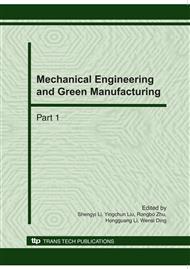[1]
KAM W. N. Overview of the ONR supercavitating high-speed bodies program[J], AIAA Guidance, Navigation, and Control Conference and Exhibit. Keystone, Colorado, 2006, 1-4.
DOI: 10.2514/6.2006-6440
Google Scholar
[2]
KIRSCHNER I. N., FINE N. E., UHLMAN J. S. et al. Supercavitation research and development[R], Undersea Defense Technologies, Waikiki, HI, Oct, 2001, 1-10.
Google Scholar
[3]
SAVCHENKO Y. N. Supercavitation-Problems and perspectives[C], CAV2001. Pasadena, CA, 2001, 1-8.
Google Scholar
[4]
SEMENENKO V. N. Artificial supercavitation: physics and calculation[R], Supercavitating Flow, von Karman Institue, Brussels Belgium, 2001, 205-237.
Google Scholar
[5]
MENG Qing-chang, ZHANG Zhi-hong, GU Jian-nong, et al. Analysis and calculation for tail-slaps of supercavitating projectile[J], Explosion and Shock Waves, 2009, 01, 56-60(in Chinese).
Google Scholar
[6]
SEREBRYAKOV V. Problems of hydrodynamics for high speed motion in water with supercavitation[C], CAV2006, Wageningen, The Netherlands, 2006, 1-16.
Google Scholar
[7]
SEREBRYAKOV V., SCHNERR G. Some problems of hydrodynamics for sub-and supersonic motion in water with supercavitation[C], CAV2003, Osaka, Japan, 2003, 1-19.
Google Scholar
[8]
SEREBRYAKOV V. Some models of prediction of supercavitation flows based on slender body approximation[C], CAV2001. Pasadena, CA, 2001, 1-13.
Google Scholar
[9]
SEREBRYAKOV V. Some problems of the supercavitation theory for sub or supersonic motion in water[R], High Speed Body Motion in Water, Kiev, Ukraine, 1997, 235-255.
Google Scholar
[10]
VASIN A. D. Supercavities in compressible fluid[R], Supercavitating Flow, von Karman Institue, Brussels Belgium, 2001, 357-385.
Google Scholar
[11]
VASIN A. D. Thin axisymmetric cavities in a subsonic compressible flow[J], Izvestiya Akademii Nauk SSSR, Mekhanika Zhdkosti i Gaza, 1987, 5, 174-177.
Google Scholar
[12]
VASIN A. D. Slender axisymmetric cavities in a supersonic flow[J], Izvestiya Akademii Nauk SSSR, Mekhanika Zhdkosti i Gaza, 1987, 1, 179-181.
Google Scholar
[13]
ZHANG Zhi-hong, MENG Qing-chang. Calculation method of supercavity profile about a slender cone type projectile traveling in water at subsonic speed[J], Explosion and Shock Wave, 2010, 30(in press, in Chinese).
Google Scholar
[14]
VLASENKO Y. D. Experimental investigation of supercavitation flow regimes at subsonic and transonic speeds[C], CAV2003. Osaka, Japan, 2003, 1-8.
Google Scholar
[15]
OHTANI K., KIKUCHI T., NUMATA D. et al. Study on supercavitation phenomenon induced by a high-speed slender projectile on water[C], 23rd IAHR Symposium, Yokohama, Japan, 2006, 1-10.
Google Scholar
[16]
HRUBES J. D. High_speed imaging of supercavitating underwater projectiles[J], Exp. Fluids, 2001, 30, 57-61.
DOI: 10.1007/s003480000135
Google Scholar
[17]
GU Jian-nong, ZHANG Zhi-hong, FAN Wu-jie. Experimental study on the penetration law for a rotating pellet entering water[J], Explosion and Shock Wave, 2005, 04, 341-349(in Chinese).
Google Scholar
[18]
LINDAU J. W., VENKATESWARAN S., KUNZ R. F. et al. Computation of compressible multiphase flows[C], 41st ASME. Reno, Nevada, 2003, 1-11.
DOI: 10.2514/6.2003-1285
Google Scholar
[19]
KUNZ J. W., LINDAU R. F. Fully coupled, 6-DOF to URANS, modeling of cavitating flows around a supercavitating vehicle[C], CAV2003. Osaka, Japan, 2003, 1-11.
Google Scholar
[20]
KUNZ R. F., LINDAU J. W., BILLET M. L. et al. Multiphase CFD modeling of developed and supercavitating flows[R], Supercavitating Flow, von Karman Institue, Brussels Belgium, 2001, 269-312.
Google Scholar
[21]
ZHANG Peng, FU Hui-ping. The numerical simulation of supercavitatoin around projectiles from subsonic to supersonic[J], Journal of Projectiles, Rockets, Missiles, and Guidance, 2009, 29, 5, 166-169(in Chinese).
Google Scholar
[22]
YI Wen-jun, WANG Zhong-yua, XIONG Tian-hong, et al. Analysis of supercavity shape for underwater projectile with typical cavitator[J], Journal of Ballistics, 2008, 20, 2, 103-106(in Chinese).
Google Scholar
[23]
VASIN A. D. Some problems of supersonic cavitation flows[C], CAV2001. Pasadena, CA, 2001, 1-14.
Google Scholar
[24]
VASIN A. D. Calculation of axisymmetric cavities downstream of a disk in subsonic compressible fluid flow[J], Fluid Dynamics, 1996, 21, 2, 240-248.
DOI: 10.1007/bf02029683
Google Scholar
[25]
VASIN A.D. Calculation of axisymmetric cavities downstream of a disk in a supersonic flow[J], Fluid Dynamics, 1997, 32, 4, 513-519.
Google Scholar
[26]
VASIN A. D. Supercavitating flows at supersonic speed in compressible water. High Speed Body Motion in Water[R], High Speed Body Motion in Water, Kiev, Ukraine, 1997, 215-224.
Google Scholar
[27]
SEMENENKO V. N. Dynamic processes of supercavitation and computer simulation[R], Supercavitating Flow, von Karman Institue, Brussels Belgium, 2001, 239-268.
Google Scholar
[28]
SEMENENKO V. N. Computer simulation of unsteady supercavitating flows[R], High Speed Body Motion in Water, Kiev, Ukraine, 1997, 225-234.
Google Scholar
[29]
SAVCHENKO Y. N. Control of Supercavitation Flow and Stability of Supercavitating Motion of Bodies[R], Supercavitating Flow, von Karman Institue, Brussels Belgium, 2001, 313-342.
Google Scholar


